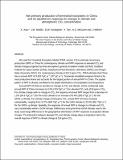Net primary production of terrestrial ecosystems in China and its equilibrium response to changes in climate and atmospheric CO₂ concentration
Author(s)
Xiao, Xiangming.; Melillo, Jerry M.; Kicklighter, David W.; Pan, Yude.; McGuire, A. David.; Helfrich III, J.V.K.; ... Show more Show less
DownloadMITJPSPGC_Rpt12.pdf (65.92Kb)
Metadata
Show full item recordAbstract
The Terrestrial Ecosystem Model (TEM, version 4.0) was used to estimate net primary production (NPP) in China for contemporary climate and NPP responses to elevated CO₂ and climate changes projected by three atmospheric general circulation models (GCMs): Goddard Institute for Space Studies (GISS), Geophysical Fluid Dynamic Laboratory (GFDL) and Oregon State University (OSU). For contemporary climate at 312.5 ppmv CO₂, TEM estimates that China has an annual NPP of 3,653 TgC/yr (10^12 gC/yr). Temperate broadleaf evergreen forest is the most productive biome and accounts for the largest portion of annual NPP in China. The spatial pattern of NPP is closely correlated to the spatial distributions of precipitation and temperature.Annual NPP of China is sensitive to changes in CO₂ and climate. At the continental scale, annual NPP of China increases by 6.0% (219 TgC/yr) for elevated CO₂ only (519 ppmv CO₂). For climate change with no change in CO₂, the response of annual NPP ranges from a decrease of 1.5% (54.8 TgC/yr) for the GISS climate to an increase of 8.4% (306.9 TgC/yr) for the GFDL-q climate. For climate change at 519 ppmv CO₂, annual NPP of China increases substantially, ranging from 18.7% (683 TgC/yr) for the GISS climate to 23.3% (851 TgC/yr) for the GFDL-q climate. Spatially, the responses of annual NPP to changes in climate and CO₂ vary considerably within a GCM climate. Differences among the three GCM climates used in the study cause large differences in the geographical distribution of NPP responses to projected climate changes. The interaction between elevated CO₂ and climate change plays an important role in the overall response of NPP to climate change at 519 ppmv CO₂.
Description
Includes bibliographical references (p. 14-17). Abstract in HTML and technical report in HTML and PDF available on the Massachusetts Institute of Technology Joint Program on the Science and Policy of Global Change website (http://mit.edu/globalchange/www/).
Date issued
1996-10Publisher
MIT Joint Program on the Science and Policy of Global Change
Other identifiers
no. 12
Series/Report no.
Report no. 12